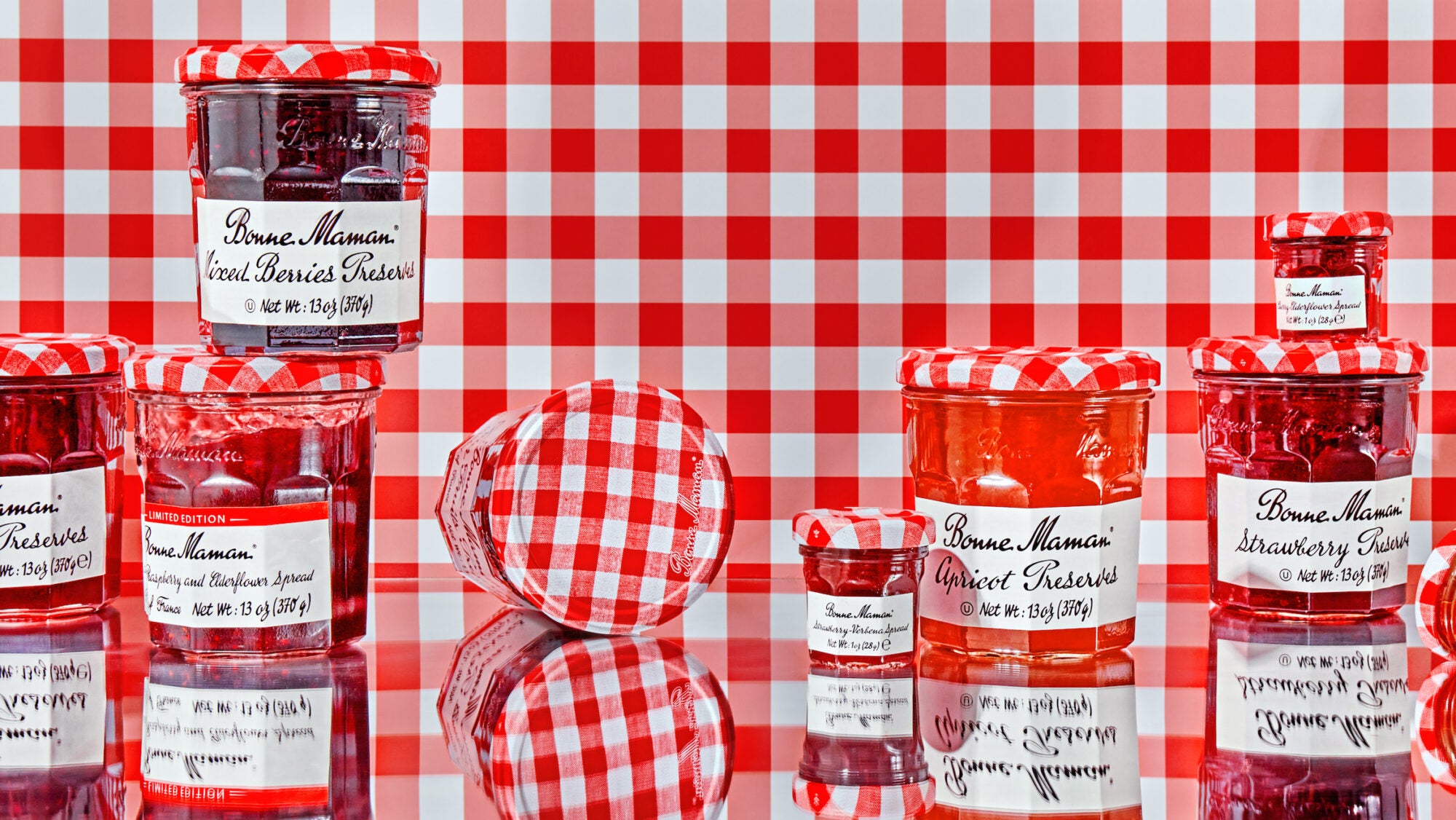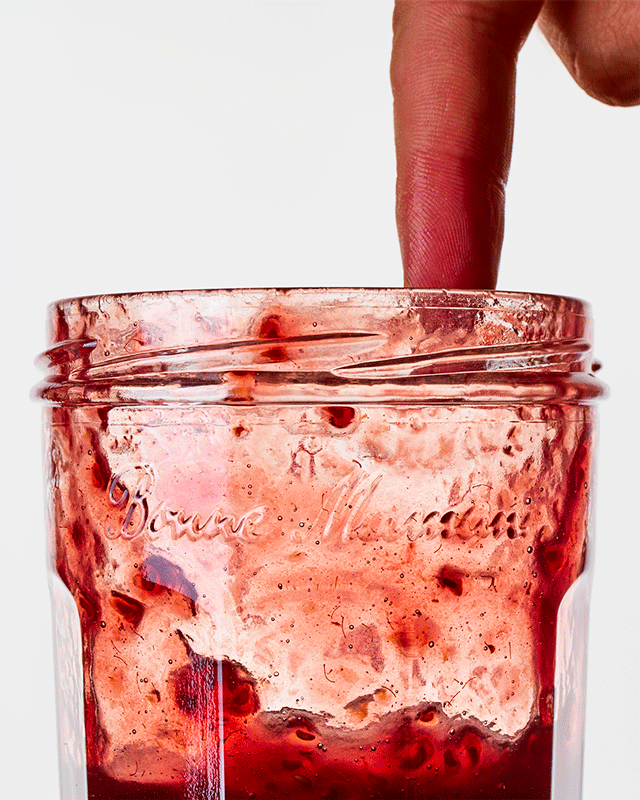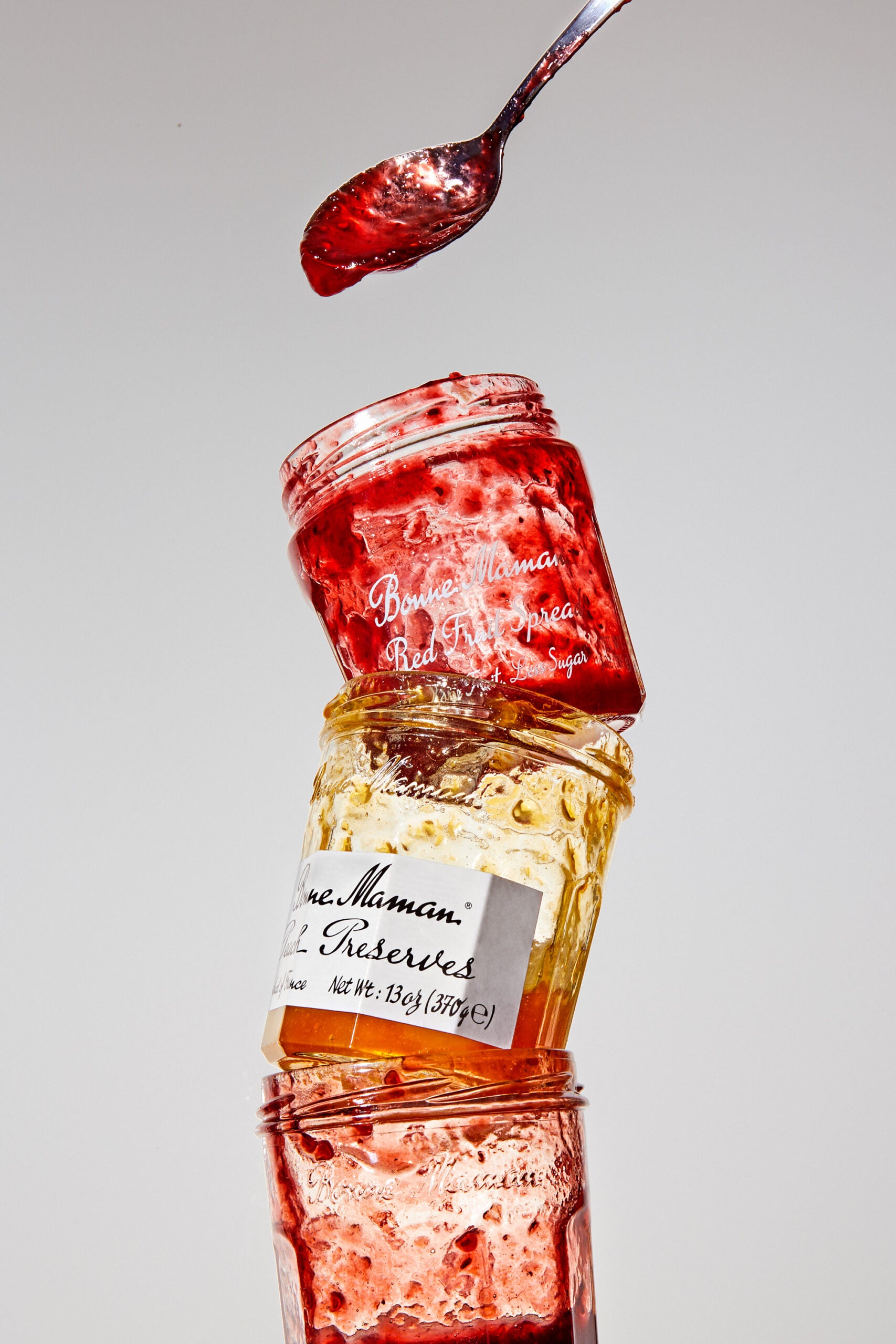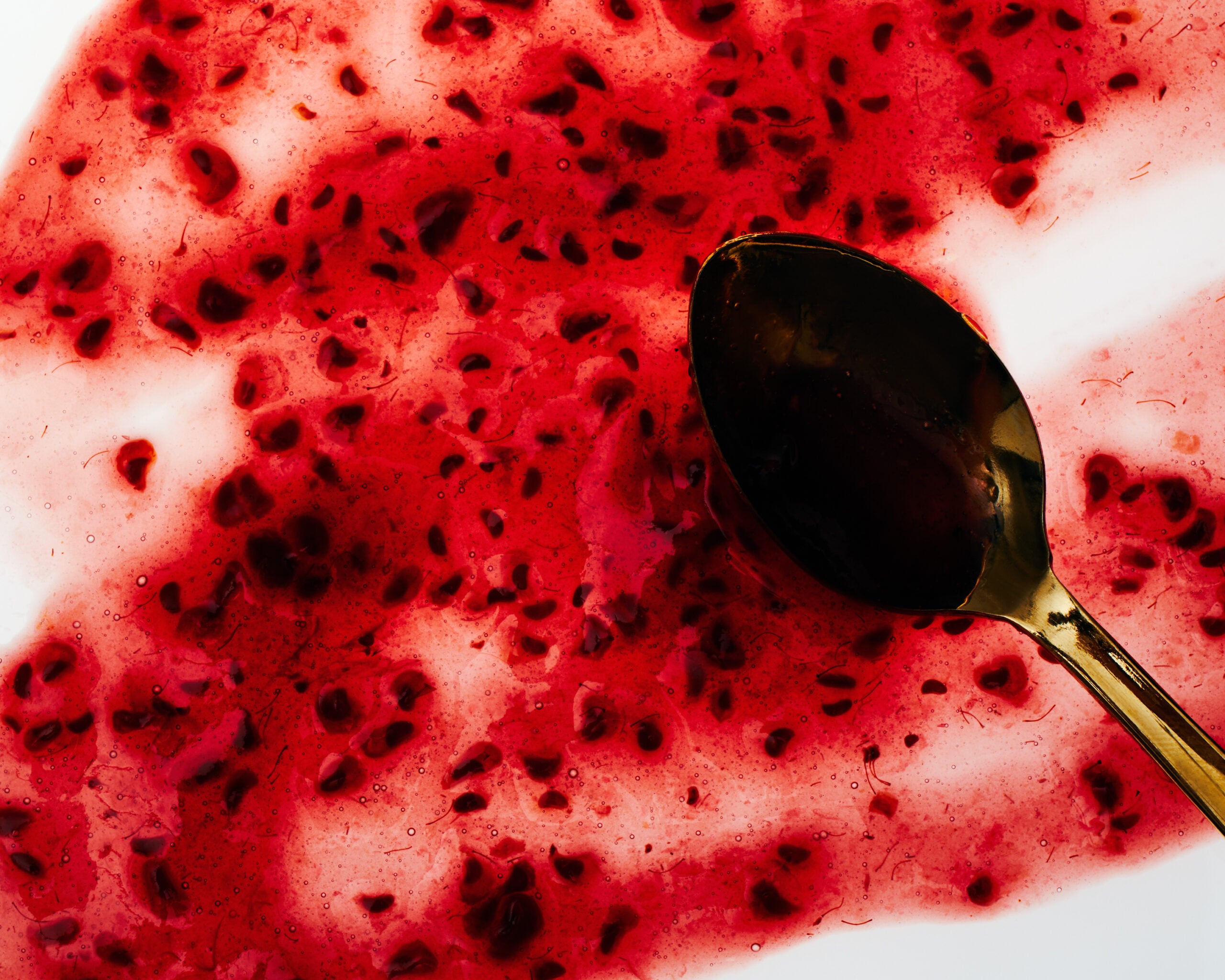
But what exactly makes it so bonne?
When I was a child, my aunt made jam. Sometimes, we had her jam, and sometimes, we had a jam from a jar with “Bonne Maman” scribbled on the label. This confused me: Bonne Maman was not my aunt, who was American and named Judie, but the jars looked so similar—it had to be homemade by someone? And at the same time, I was vaguely aware that this could not possibly be right. I’d seen it in the grocery store, which seemed like an implausibly high volume for one aunt. I couldn’t parse it, which I found unsettling. Who was this Bonne Maman?
By early adolescence, I had a better grasp of brands. Even then, I understood that Bonne Maman occupies a singular place in the landscape of preserves. (It is a preserve and not technically a jam, because jams use pulverized fruit while preserves use whole fruit; Bonne Maman also makes a jelly, which uses fruit juice.) Its jars are instantly recognizable, with their iconic gingham screw tops. It is relatively affordable ($5.99 at my local New York City Stop & Shop) and easily accessible (found at major grocery stores, minor grocery stores, many bodegas, and sometimes CVS), yet it maintains an exotic air of Frenchness. “It feels like it came from a faraway place made by an old person,” the food writer Alison Roman told me. It is, in her estimation, the “gold standard” of commercial jams, and when, for a few years in her early 20s, Roman briefly had a jam company, her goal was “to be the Bonne Maman of Brooklyn.” Which is, of course, an oxymoron, because Bonne Maman is, above all else, French.
Beyond that fact, I knew very little about Bonne Maman, except that it existed and seemed to have always existed, and that everyone seemed to love it although nobody could say exactly why, or where it came from, or how it came to dominate American grocery stores. Google yielded startlingly little information, though it did suggest that other people had similar questions, including, “Why is Bonne Maman so good?” (answer: the fruit) and “Is Bonne Maman a French brand?” (answer: yes). From a press release, I learned it was the number-one “premium preserves” in the United States; from a spokesperson from the market research firm Packaged Facts, I learned that jam and jelly sales took off during the pandemic, outpacing even nut butters (“the frequent companion of jams and jellies”), and that while the market has since dipped again as shopping patterns have normalized, sales of “higher value” products such as jam have dropped less.
None of this answered my overarching question, which was how a mysterious French import became synonymous with jam. “Honestly, other than Smucker’s, I couldn’t tell you another jam brand,” Roman said. I couldn’t either. There was silence on the line.
You don’t realize it’s everywhere until you start looking for it, but then you can’t escape the stuff. It was on the shelf in my bodega and on display at my local French patisserie in tiny, one-ounce jars. In this summer’s Marcel the Shell with Shoes On movie, red gingham Bonne Maman lids double as shell-size bistro tables.
I looked at my own kitchen counter: a Bonne Maman jar, holding change. I searched Twitter for insight but found enthusiasm instead. “Bonne Maman could sell me anything,” someone had tweeted. “I would buy a jar of rocks. I would buy Bonne Maman life insurance.” Last year, the brand went viral when a law professor tweeted about meeting a Holocaust survivor in the jam aisle who’d told him that the family behind the company had hid her family in Paris during World War II. Was it true? Who knows! Nobody could conclusively verify it happened, although they couldn’t verify it didn’t happen; the official line from Bonne Maman was that “the family prefers to maintain privacy and does not comment on inquiries about personal matters.”
The company prefers not to comment on jam matters, either, generally avoiding press. In a rare interview with the French magazine Capital, Frédéric Gervoson, then head of the Andros group, explained that the company is devoted to the art of jam and not to spectacle. “It’s not a zoo here!,” he said.
This philosophy of silence only adds to the company’s allure. “That’s kind of a French thing anyway,” observed Maryann Tebben, director of the Center for Food Studies at Bard College at Simon’s Rock. “They don’t want to reveal their secrets.” What makes French food French, she argues, is not just its point of origin but its je ne sais quoi: “It’s good ingredients. It’s well made. But there’s something extra that you can’t quite put your finger on that just makes it special.”
Here is what we do know: Jean Gervoson founded a company called Andros in the southwestern village of Biars-sur-Cère in the late 1950s, selling preserves. In 1971, he and his wife, Suzanne, the daughter of a fruit merchant, officially launched the Bonne Maman label, and by the mid-’70s, it had landed in the United States. The brand currently falls under the umbrella of the Andros group, which, despite its size—Andros brought in an estimated $2.4 billion in 2019 across a variety of brands—is wholly family-owned. While the Bonne Maman lineup of products has expanded, the premise remains the same: a commercial preserve that looks and feels homemade, the kind of product that can transport you to a past you may never have had. It was a hit from the beginning; even actual French people, it turns out, want fictional French grandmas.
In the years since its founding, Bonne Maman has become a jammy institution. It is available in 125 different countries, remains the top-selling preserves brand in France and the second-best seller in the United States, and comes in more than 25 flavors, if you count the jellies, spreads, and curds.
Bonne Maman is the French girl of the supermarket: familiar but glamorous.
None of this explains the endurance or intensity of Bonne Maman’s appeal. I called Camilla Wynne, a professional jam maker in Toronto who has written multiple cookbooks, to consult her on the appeal of the brand. “I wouldn’t say I have a definitive answer,” she told me, with Canadian modesty. But she did have a suggestion: it is the rare store-bought jam worth eating. “They just have a better ingredient list,” she said: lemon juice instead of citric acid; cane sugar rather than high-fructose corn syrup. “I feel like they cook it down more, too, so there’s more fruit per tablespoon, just by the texture and the taste.” We paused. “It’s a real detective game you’re playing, but I think the thesis is definitely correct.”
“I mean, it’s delicious,” pastry chef Caroline Schiff, currently of Brooklyn’s Gage & Tollner, concurred. “It’s not overly sweet, which I think is really key.” And, she pointed out, it’s strikingly consistent: when they’re writing recipes for mass consumption, pastry chefs often calibrate to Bonne Maman because almost everyone can get it, and it always tastes the same. “Their level of sugar and pectin is spot-on,” she said. It is sweet but dignified; it is not overly gelatinous but it also does not run.
Then there’s the jar. “It’s such an iconic jar!” exclaimed Schiff’s colleague, Kathryn Irizarry, a jam aficionado and Bonne Maman enthusiast. The jar, everyone agreed, is a selling point, and while I knew this, I was not prepared for so many people to enumerate so many different virtues in such detail. It is sturdy, cheerful, unfussy, nostalgic; the ten-sided body just feels nice in your hand. “The label comes off really easily,” raves Paris-based cookbook author David Lebovitz, highlighting one of its less-discussed merits. Gautier Coiffard, the Frenchman behind the Brooklyn bakery L’Appartement 4F, praises its particular shape, which has plenty of room for a spoon to maneuver, being neither too tall nor too thin. “You never throw out one of those jars,” Schiff confirms, ominously offering to send a picture of her pantry. They are ideal for storage of all kinds—and also great for drinking, exuding an effortless air of laid-back Frenchness. (This is despite the fact that in France, according to Lebovitz, “drinking out of one is considered un peu bizarre.”)
The “French girl” is a fashion trope: chic without trying, windswept but well-tailored, all the more beautiful for being unadorned. Bonne Maman is the French girl of the supermarket: familiar but glamorous. Foreign but pronounceable. “If you think about the flavors, they’re not just the standard ones,” says Tebben. There is raspberry and strawberry, but there’s also fig and blackcurrant and Mirabelle plum, which are supremely accessible but also “not totally something we have here,” she says. “It’s a little bit unusual but not so far off.”
I ask her for equivalents—other products at average grocery stores that sell a fantasy of France. Evian feels dated. Perrier is now just one bottle in a sea of fizzy waters. Maille mustard might be a candidate, but there are no articles dedicated to Maille mustard jar hacks. (Tebben suspects the name may be too hard to pronounce.) We come up blank. “Maybe that’s it—that Bonne Maman occupies its own niche,” she says.
The jar is cute. Five-dollar luxuries are rare. France is nice, especially the imaginary version, with a universal grandma canning blackberries in the sun. And still, it is hard to escape the most obvious conclusion: that the reason for Bonne Maman’s supremacy is that Bonne Maman is good. “If it weren’t good, no one would buy it,” Roman says, simply. “The reason they’ve been on the shelves for so long is that it’s a good jam and people like it.”


